The height of the suspended toilet from the floor and other
How practical is suspended plumbing? What should be the installation height of the toilet and how to install it correctly? In the article we will try to answer these questions, and at the same time dispel several myths surrounding this type of plumbing fixtures.
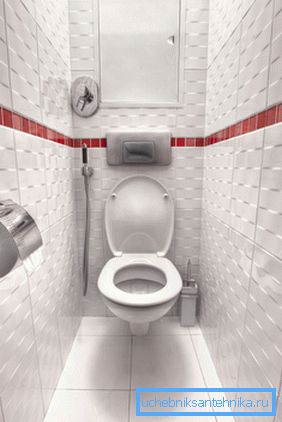
On the floor or above the floor
In advertising brochures, telling about the merits of toilet bowls, the following main theses are presented:
- Suspended plumbing does not interfere with cleaning, leaving the entire floor area accessible.
- It makes a compact toilet spacious., allowing you to save space at the expense of the tank.
- It allows you to completely hide the communication, thereby improving the appearance of the bathroom.
Let's try to figure out how much truth marketers say.
Free floor
The statement is true without reservation. The installation - the frame to which the toilet is attached, hides behind the false wall, leaving the entire floor area accessible.
This means that in your bathroom there will no longer be dark and damp places under the cistern, that the cleaning of the toilet doesn’t really hurt the foundation of the toilet, and changing the tile will not require dismantling it. Not only that: the vacated floor will give more room to your imagination when choosing a flooring pattern.

Compactness
Console plumbing will really make the room more spacious, but only visually. Dimensions of a suspended toilet with a flush-mounted cistern and installation are at least as large as the floor structure: due to the thickness of the false walls, they are likely to be somewhat larger.
Note: the back wall of the toilet room will move forward about 20 centimeters, thereby making it impossible for you to use the space behind the toilet to create shelves or a small closet.
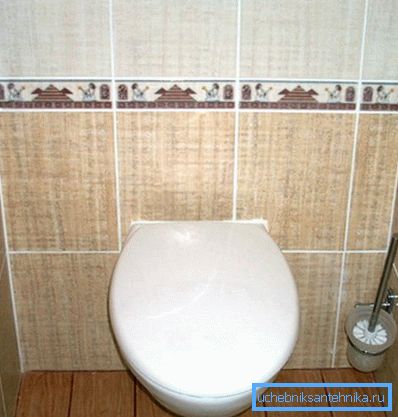
The visual space will be associated with the peculiarities of human perception of the size of the room. They are unconsciously evaluated on the area of two planes - the floor and the ceiling. Since the floor in our case is not cluttered, the toilet, despite the actual reduction in floor space, will seem somewhat less cramped.
By the way: mezzanines also visually reduce the room. If you want to use part of the space of a small bathroom for storing rarely used things, it is better to build a flat closet all over the wall and provide it with mirrored doors.
Hidden communications
Yes, they really will be completely hidden. In sight, in addition to the bowl of the toilet, there will be only a drain button. Yes, it will be beautiful, but defiantly impractical.
You see, dear reader, the author of this article for a decade of work as a plumber made sure that any construction needs to be repaired sooner or later, be it plumbing, sewage, drain cistern or valve. To make communications difficult to access means to create difficulties for yourself in the future. Even after 10 or 20 years.
Not only that: in a compact city apartment, the back wall of the toilet, which is usually hidden by a false wall along with the installation, is decorated with water and sewage risers. Even if you are not too lazy to pre-replace them with durable polymer or metal-polymer pipes - who can guarantee that they will not be damaged by a pressure surge? Or, alternatively, do not need to replace the section of the riser in the ceiling (which is more than not uncommon)?
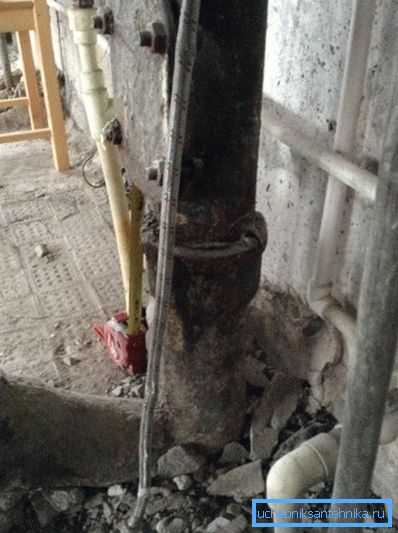
Findings? Everyone will do it for themselves. Let's just say: the author never had the thought to choose something other than the classic floor construction.
Dimensions and distances
Didn't the criticism of the solution we are discussing scare you? Well, let's move on to the next stage.
The size of the suspended toilet and the installation to it varies depending on the manufacturer and model within fairly wide limits.
| Dimension | Value mm |
| Length (from the wall) | 500 - 600 |
| Width | 300 - 400 |
| Bowl height | 300 - 400 |
| Installation depth | 150 - 300 |
| Installation height | 800-1400 |
| Installation width | 500 - 600 |
At what height should the wall mounted toilet be fixed to the wall? The optimal values are in the range of 400 to 450 millimeters.
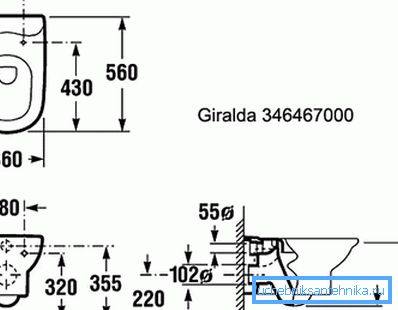
As always, there are a number of nuances.
- Do not forget about the thickness of the seat. By setting the edge of the toilet to a height of 450 mm, and setting the seat, you may be confronted with the fact that the height has become uncomfortably large.
- The height is chosen from the level of the floor finish. If you put the toilet so that its edge was 400 mm from the floor, and then pour the screed and put the tile - when you visit the toilet you will have problems with hearing. Ears will be plugged with knees.
- Finally, if the growth of your family members differs significantly from the average in one direction or another, the height of the toilet can be adjusted accordingly.
Do not forget about the location of the subject of plumbing in the room.
- The distance from the edge of the bowl to the wall, bidet, washing machine, etc. ideally should not be less than 20 centimeters. The distance to these objects from the longitudinal axis of the bowl should not be less than 40 cm.
- A reasonable minimum distance from the front edge of the seat to the door is 60 cm. No, the closest door doesn’t hurt to sit down, but it is even possible to fix the clothes.
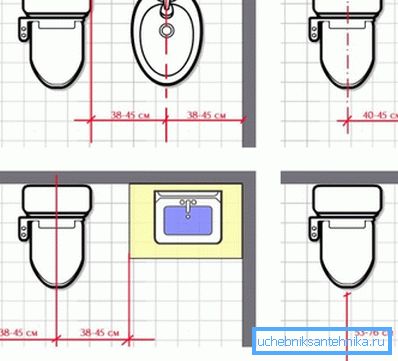
- The optimum height of the drain button is about one meter from the floor.
Useful tips
Allow yourself to give the reader a happy advice on the selection and installation of sanitary equipment of interest to us.
Selection
As well as floor, suspended toilet bowls can be made of different materials. Let's try to give them a rating.
Polished stainless steel is practically non-contaminated due to its exceptionally smooth surface. If the deposits are still left on it - they are easy to remove using any preparation of household chemicals.

Why does a stainless steel occupy a much smaller part of the market than competing solutions?
There are two reasons:
- Several breech type of steel plumbing. She came to be known as anti-vandal equipment for public toilets and caused the corresponding associations in the majority of potential buyers.
- In addition, the price of stainless steel toilets is much higher than that of ceramic counterparts, and starts from about 20,000 rubles.
Glass is a little inferior to stainless steel practicality; However, looking through the translucent walls of what remains on the walls of the bowl below the water level is a rather dubious pleasure.
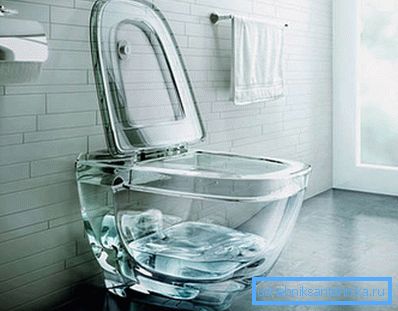
The main problem of polymer concrete is limited resistance to aggressive cleaning products and scratches. It is not a trivial task to remove a urinary stone and lime deposits from it without disturbing the appearance of the surface.
The main value of sanitary ware is cheap. That is why he is the undoubted leader in the plumbing market. The disadvantage is that its large-pore surface actively collects pollution and often needs cleaning.
Glazed faience due to the vitreous coating is much more resistant to dirt and easier to be listed, almost no different from the material without glaze in cost.
Finally, the best material for the combination of cost and functionality is porcelain. The walls of the toilet will remain white for a long time; if the need for cleaning does arise, it is safe to use acid and alkaline preparations for it.
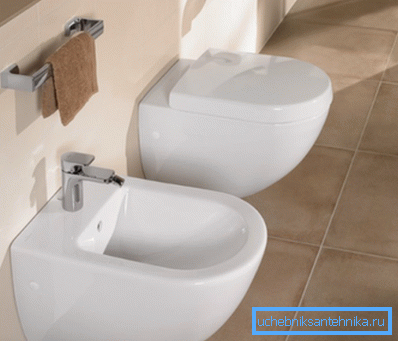
Installation
Are there any subtleties in the installation of a suspended toilet with their own hands?
The installation steps themselves are exhaustively described in the accompanying documentation:
- The location of the frame installation is marked by level or plumb.
- She ankertes to the wall and / or floor.
- Water is supplied to the tank, and a sewer pipe is located at the location of the toilet bowl socket.
- The opening of the tank under the drain button is closed with a special membrane or ordinary polyethylene, after which the installation and communications are hidden by a false wall. As a rule, it is assembled from moisture-resistant drywall along a galvanized profile and is laid out with tiles.
- After the tile has securely gripped, a toilet bowl is hung on the installation studs, and a drain button is installed in the tank. Between the toilet and the wall is mandatory laying-damper that distributes the load on the tile and does not allow chipping.

By the way: in the absence of a gasket, silicone sealant can perform its role.
There are several nuances here too:
- It is better to start the tile from the drain button, so that the seams are located symmetrically about the center of the button. Asymmetry does not look very neat.
- The shorter the drainage to the riser - the less likely it is clogged. Do not forget about the slope: for used when flush-mounted pipes with a diameter of 90 and 110 mm, it is equal to 2 cm per linear meter.
- Sewer is better to collect on sealant. The instruction is connected with the fact that rubber seals can lose elasticity over time and cause leakage.
- Forget about flexible liner. Water is supplied to the tank with a rigid pipe. The service life of a rubber hose in braid rarely exceeds 5 years.
- Despite the fact that the tank fittings usually allow you to shut off the water through the process hatch behind the drain button, it is better to provide the supply pipe with a valve and leave the hatch in the false wall to access it.
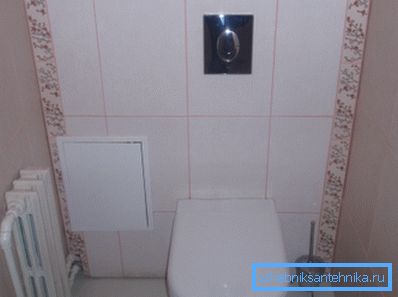
Conclusion
Of course, in a small material we could not touch on all the subtleties and nuances of the choice and installation of overhead plumbing. For more information, the reader will find in the video in this article. Successes!